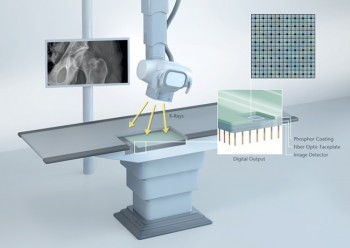SCHOTT’s new Fiber Optic Faceplates and BOROFLOAT® Glass

X-ray process with fiber optics faceplates
Photo by © Swisslog
SCHOTT technology is advancing digital X-rays for hospitals and clinics, scientific labs, and defense and transportation applications. With SCHOTT’s fiber optic faceplates and BOROFLOAT® glass, X-ray technicians are able to decrease radiation doses while still generating sharp and clear images with less noise.
By protecting a digital X-ray’s complementary metal oxide semiconductor (CMOS) sensors, SCHOTT’s RoHS-compliant large format fiber optic faceplates helps to make higher-quality images with lower doses of radiation. SCHOTT produces these plates in conformity with ISO9001:2008 and ISO13485:2003 standards; all of SCHOTT’s Lighting and Imaging facilities are ISO certified.
SCHOTT’s faceplates allow for high resolution images through high X-ray absorption and contrast, and are manufactured as large as 320 mm x 320 mm. These fused fiber optic faceplates integrate fiber optic elements ranging from 6 microns in diameter to 25 microns or larger.
“Digital X-ray imaging demands faster speeds and higher dosage levels, but too much radiation can create noise and ultimately damage sensitive CMOS detectors,” said Jeff Lowe, Senior Project Manager, Medical at SCHOTT. “The integration of fiber optic faceplates into CMOS detectors has allowed for significantly improved image resolution, which ultimately helps to improve the patient experience.”
SCHOTT provides another promising material with potential utilization as a scintillator substrate, cover glass or component for indirect or direct flat panel detectors in digital X-ray machines. BOROFLOAT®, a floated borosilicate glass, holds several advantages over traditional soda-lime or alkali-free glasses, all of which stem from its extraordinary glass structure. Because BOROFLOAT® glass has less non-binding oxygen holes in its microstructure, the glass shows significantly less darkening and structural degeneration when exposed to high-energy radiation; other glasses deteriorate and darken from high-intensity X-rays because their extra oxygen atoms are prone to electron hole defect generation when exposed to radiation.
X-ray detector manufacturers also rely on BOROFLOAT® glass for its superior finish, including excellent flatness and surface quality; its heat-resistance during processing; its low coefficient of thermal expansion and high glass transition temperature; and low weight.
“BOROFLOAT® glass’s versatility helps it excel in any type of application, from X-ray detectors to cover glasses and wafer substrates,” said Tina Gallo, BOROFLOAT® Applications Manager at SCHOTT. “It is a lightweight, highly transmissive, and rugged glass that is resistant to heat, chemicals and radiation, and aids industries from medicine to transportation.”
For more information visit: http://www.us.schott.com/
News Categories
- » NEWS HOME
- » Automation & Robotics
- » Industry 4.0
- » Material Handling
- » Sensors
- » Quality & Testing
- » Machine Vision
- » Laser & Optics
- » Metalworking
- » Motion Control & Drives
- » Hydraulics & Pneumatics
- » Process Industry
- » Renewable Energy
- » Agriculture
- » Home & Office Furniture
- » Environmental Tech









